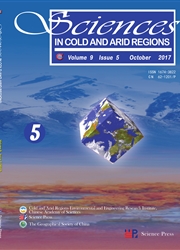

 中文摘要:
中文摘要:
利用1951—1999年NCEP/NCAR(2.5°×2.5°)再分析逐月资料,分析了我国西北地区的水汽输送和收支的平均状况.结果表明:我国西北地区的水汽输送主要集中在夏季,西风气流是西北地区水汽输送的主要载体,大西洋、北冰洋、黑海和里海是西北地区水汽输送的主要源地;西风气流输入到西北地区的大部分水汽继续向东扩散,最后从东边界输出.选择夏季,根据设计的区域西风指数研究了区域西风指数对西北地区水汽输送以及收支的指示性,经检验,区域西风指数对西北地区的水汽输送和收支有良好的指示性,夏季区域西风指数异常强(弱)年份西风气流输入西北地区的水汽量大(小),同时水汽净收支大(小),有(不)利于降水的形成.
 英文摘要:
英文摘要:
Based on the monthly data of NCEP/ NCAR in the period of 1951-1999, with a resolution of 2.5°×2.5°, the average transportation and budget of water vapor in Northwest China are analyzed. It is found that the water vapor transportation concentrates in summer, the westerly is the main carrier, the Atlantic, the Arctic Ocean, the Black Sea and the Caspian Sea are the main water vapor sources, and the most part of the water vapor transported to Northwest China continuously moves eastwards and exports across the east sideline. Since westerly is the main carrier of water transportation in Northwest China, and the maxi-mum of water vapor transportation appears mer, summer is chosen for further research sum- Analyzing the designed regional westerly indexes, the research shows that the regional westerly index is a very good index for studying both the westerly water vapor transportation and budget of the water vapor transportation in Northwest China: in summer, a larger (smaller) index indicates that more (less) water vapor is transported to Northwest China by the westerly, and also, the budget of water vapor is more (less), resulting in more (less) precipitation.
 同期刊论文项目
同期刊论文项目
 同项目期刊论文
同项目期刊论文
 期刊信息
期刊信息
